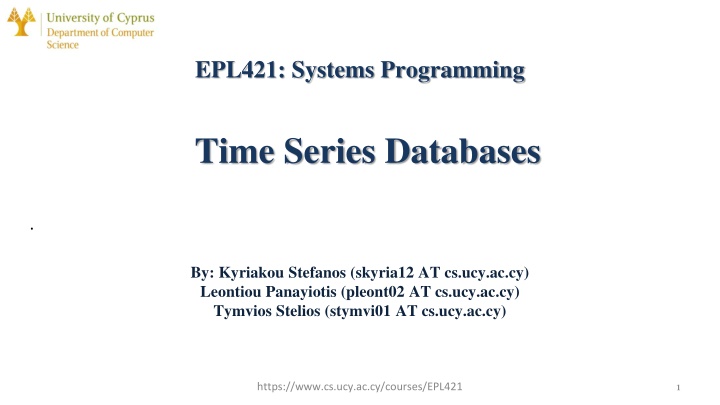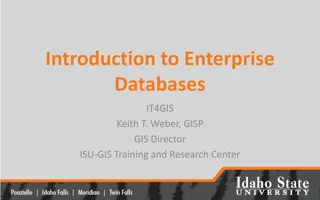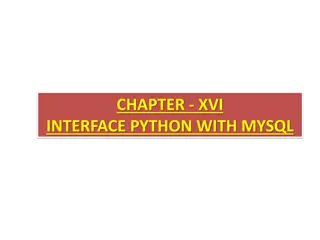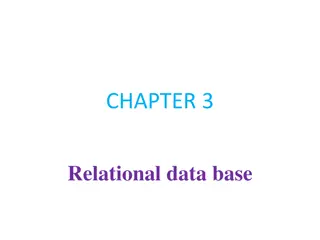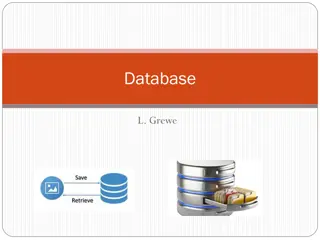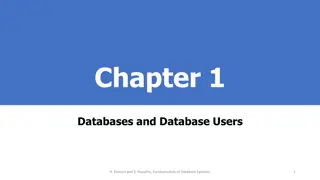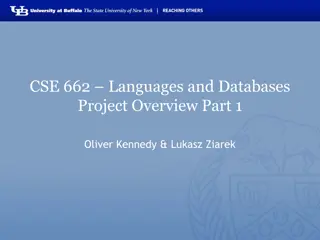Overview of Time Series Databases in Systems Programming
This content delves into the intricacies of time series databases within the realm of systems programming, comparing options like InfluxDB. It discusses relational vs. tagset data models, setup procedures, API usage, security considerations, advantages and disadvantages of relational data models, and more.
Download Presentation

Please find below an Image/Link to download the presentation.
The content on the website is provided AS IS for your information and personal use only. It may not be sold, licensed, or shared on other websites without obtaining consent from the author.If you encounter any issues during the download, it is possible that the publisher has removed the file from their server.
You are allowed to download the files provided on this website for personal or commercial use, subject to the condition that they are used lawfully. All files are the property of their respective owners.
The content on the website is provided AS IS for your information and personal use only. It may not be sold, licensed, or shared on other websites without obtaining consent from the author.
E N D
Presentation Transcript
EPL421: Systems Programming Time Series Databases . By: Kyriakou Stefanos (skyria12 AT cs.ucy.ac.cy) Leontiou Panayiotis (pleont02 AT cs.ucy.ac.cy) Tymvios Stelios (stymvi01 AT cs.ucy.ac.cy) 1 https://www.cs.ucy.ac.cy/courses/EPL421
Main presentation topics Relational vs Tagset data model What is a time series database and some of the current available options InfluxDB compared to other time series databases Setup of Couchbase, anyplace and influxDB Api Usage Security issues InfluxDB Tutorial https://www.cs.ucy.ac.cy/courses/EPL421 2
Relational data model The database management system is responsible for describing the data structures, for storing data and retrieval procedures are responsible for answering queries Most relational databases use the SQL data definition and query language Each time-series measurement is recorded in its own row, with a time field followed by any number of other fields Fields support various and more complex data types Create indexes on any field or on multiple fields Any of these fields can be used as a foreign key to secondary tables https://www.cs.ucy.ac.cy/courses/EPL421 3
Advantages of Relation data model A narrow or wide table, based on how much data and metadata we want to record per reading Many indexes to speed up queries or few indexes to reduce disk usage Denormalized metadata within the measurement row, or normalized metadata that lives in a separate table A rigid schema that validates input types or a schemaless JSON blob to increase iteration speed Check constraints that validate inputs, for instance checking for uniqueness or non- null values https://www.cs.ucy.ac.cy/courses/EPL421 5
Disadvantages of Relation data model Need to select a schema and explicitly decide whether or not to use indexes https://www.cs.ucy.ac.cy/courses/EPL421 6
Tagset data model Each measurement has a timestamp, an associated set of tags (tagset) and a set of fields (fieldset) The fieldset represents the actual measurement data values. The tagset represents the metadata to describe the measurements Field data types are limited to floats, ints, strings, and booleans, and cannot be changed without rewriting the data Tagset values are always represented as strings and cannot be updated Tagset values are indexed while fieldset values are not https://www.cs.ucy.ac.cy/courses/EPL421 7
Advantages of tagset data model Very easy to get started No need to create schemas or indexes https://www.cs.ucy.ac.cy/courses/EPL421 9
Disadvantages of Tagset data model Rigid and limited, with no option to create any additional indexes The underlying schema is auto-generated based on the input data, which may differ from the desired schema https://www.cs.ucy.ac.cy/courses/EPL421 10
What is a Time series database (TSDB)? A software system that is optimized for storing and serving time series through associated pairs of time and values. https://www.cs.ucy.ac.cy/courses/EPL421 11
Why time series DBs are exploding in popularity? Enterprises want to be able to query, analyze and create reports based on streaming data in real-time, instead of batch mode. Over past years, time series databases have exploded in popularity, according to database engines data https://www.cs.ucy.ac.cy/courses/EPL421 12
No database type has grown faster in popularity than time series DBs https://www.cs.ucy.ac.cy/courses/EPL421 13
According to Timescale CEO Ajay Kulkarni Time-series datasets track changes to the overall system as INSERTS, not UPDATES. What makes time-series data so powerful is the fact that they record each and every change to the system as a new different row. Time-series databases introduce the ability to analyze how something changed in the past. In addition they can be monitored to see how something is changing in the present, or even to make predicting about how it may change in the future https://www.cs.ucy.ac.cy/courses/EPL421 14
Choosing a time series DB Check what they offer and if those fit your needs Should be OpenSource No data size limitations Free to use DB Fast and efficient https://www.cs.ucy.ac.cy/courses/EPL421 15
Some of the available options InfluxDB Graphite TimescaleDB OpenTSDB VictoriaMetrics https://www.cs.ucy.ac.cy/courses/EPL421 16
InfluxDB Date of birth: 2013 Ranked in the first place in the last 3 years (2017-2019) Completely open-source time series database Working on all current operating systems Supports a very large set of programming languages Optimized for heavy writing load Works amazingly well with concurrency Schema-Free database https://www.cs.ucy.ac.cy/courses/EPL421 17
Why choose InfluxDB? Super easy to install, configure and launch As a NoSQL-like database, you don t have to setup your database InfluxData provides a visualization tool Uses Flux, a new processing language, which is becoming a new tech trend, or an SQL-like language (it can also be used with HTTP requests) Gives more power to the user but at the same time reduces the power of the database Stores data in LSM trees, which are better suited for storing time series data comparing to general-purpose storage provided by Postgresql Drawbacks: 1. No same-time insert 2. Poor performance for deletion with predicates https://www.cs.ucy.ac.cy/courses/EPL421 18
Graphite Very widely used time series database system Powerful monitoring tool that stores numeric time series data Can display the stored data on demand via its Graphite-web interface at a fair speed Most of the time used as a system, network and application performance metric store Big companies such as Booking.com, Reddit and GitHub use it on a daily basis to be able to easily detect outage on their architecture https://www.cs.ucy.ac.cy/courses/EPL421 19
Why choose Graphite? Built to deal with numeric data Graphite Web is an interface for developers to monitor their application Connects with a lot of tools natively Makes it easy for developers to connect with their existing infrastructure https://www.cs.ucy.ac.cy/courses/EPL421 20
TimescaleDB Open-sourced Based on SQL premises Very large set of supported programming languages Directly tied with PostgresSQL Offers a unique set of time series related operations (like fast ingest) https://www.cs.ucy.ac.cy/courses/EPL421 24
Why choose TimescaleDB? Supports the SQL language natively No need to learn a new language Big companies rely on SQL-constraint systems in order to ensure system reliability and accessibility Drawbacks: 1. Quickly reaches disk bandwidth limit, which can be lifted by using more expensive disks with higher read / write bandwidth such as high-end SSDs 2. Requires much more storage space comparing to VictoriaMetrics and InfluxDB for storing the same amount of data points https://www.cs.ucy.ac.cy/courses/EPL421 25
https://www.cs.ucy.ac.cy/courses/EPL646 https://www.cs.ucy.ac.cy/courses/EPL421 26
OpenTSDB Able to store hundreds of billions of data rows over distributed instances of TSD servers Schema free database built on Apache HBase HBase is a non-relational management system written to handle big tables storage in an elegant and efficient way https://www.cs.ucy.ac.cy/courses/EPL421 28
Why choose OpenTSDB? Can handle several millions writes per second Better performance than InfluxDB, when dealing with more than one million writes per second. OpenTSDB integrates with Cassandra, BigTable, CollectD, StatsD, Chef and even Puppet for deployment management https://www.cs.ucy.ac.cy/courses/EPL421 29
VictoriaMetrics Supports native PromQL (doesn t support SQL) Supports wide range of retention periods starting from 1 month Compresses on-disk data better than competitors (according to their website), which means it can handle longer retentions without downsampling Excels on heavy queries over thousands of metrics with millions of data points Open Source under Apache2 license https://www.cs.ucy.ac.cy/courses/EPL421 33
Why choose VictoriaMetrics? Requires fewer hardware resources (RAM, CPU, storage) which allows for saving hardware costs Outperforms InfluxDB and TimescaleDB on data ingestion VictoriaMetrics has the best optimization for disk IO bandwidth usage, compared to InfluxDB and TimescaleDB. VictoriaMetrics provides better vertical scalability for both data ingestion and querying, compared to InfluxDB and TimescaleDB Stores data in LSM trees, which are better suited for storing time series data comparing to general-purpose storage provided by Postgresql Drawbacks: It is a relatively new database, which was written from scratch and may contain unpolished code https://www.cs.ucy.ac.cy/courses/EPL421 34
RAM usage for various cardinalities https://www.cs.ucy.ac.cy/courses/EPL421 37
Our mission Install and configure couchbase Install and configure anyplace Install and configure influxDB Create API endpoints to connect anyplace with influxDB https://www.cs.ucy.ac.cy/courses/EPL421 38
What is Anyplace? A free and open Indoor Navigation Service with excellent accuracy A first-of-a-kind indoor information service offering GPS-less localization, navigation and search inside buildings using ordinary smartphones https://www.cs.ucy.ac.cy/courses/EPL421 39
Awards 2018 - Best Demo Award 19th IEEE International Conference on Mobile Data Management June 26 - June 28, 2018, Aalborg, Denmark. 2017 - Honorable Mention Award 18th IEEE International Conference on Mobile Data Management May 29 - June 1, 2017, KAIST, Daejeon, South Korea. 2014 - 1st place at Evaluation of RF-based Indoor Localization Solutions for the Future Internet (EVARILOS Open Challenge), European Union, Berlin, Germany 2014 - 2nd place at Microsoft Research Indoor Localization Competition at IEEE/ACM IPSN 2014, Berlin, Germany. 2012 - Best Demo Award at IEEE Mobile Data Management Conference, Bangalore, India. https://www.cs.ucy.ac.cy/courses/EPL421 40
Anyplace architecture https://www.cs.ucy.ac.cy/courses/EPL421 41
Anyplace architecture https://www.cs.ucy.ac.cy/courses/EPL421 42
Scala Object-oriented and functional programming high-level language Scala's static types help avoid bugs in complex applications Its JVM and JavaScript runtimes gives the ability to users to build high-performance systems and gives access to huge ecosystems of libraries https://www.cs.ucy.ac.cy/courses/EPL421 43
Play framework Lightweight, stateless, web-friendly architecture Uses Akka and Akka Streams under the covers to provide predictable and minimal resource consumption (CPU, memory, threads) Akka and Akka Streams abstract away from the imperative nature of how the data is inputted into the application giving us a declarative way of describing, handling it and hiding details that we don t care about. Streaming helps you ingest, process, analyze, and store data in a quick and responsive manner. https://www.cs.ucy.ac.cy/courses/EPL421 44
What is couchbase? An open-source, distributed multi-model NoSQL document- oriented database software package that is optimized for interactive applications. Designed to provide easy-to-scale key-value or JSON document access with low latency and high sustained throughput. Designed to be clustered from a single machine to very large- scale deployments using many machines. https://www.cs.ucy.ac.cy/courses/EPL421 45
Installation & configuration of Couchbase Install Couchbase: curl -O https://packages.couchbase.com/releases/couchbase- release/couchbase-release-1.0-6-amd64.deb sudo dpkg -i ./couchbase-release-1.0-6-amd64.deb sudo apt-get update sudo apt-get install couchbase-server-community Please note that you have to update your firewall configuration to allow connections to the following ports: 4369, 8091 to 8094, 9100 to 9105, 9998, 9999, 11209 to 11211, 11214, 11215, 18091 to 18093, and from 21100 to 21299. https://www.cs.ucy.ac.cy/courses/EPL421 46
Installation & configuration of Couchbase Start couchbase: sudo service couchbase-server start Stop couchbase: sudo service couchbase-server stop Check status: sudo service couchbase-server status https://www.cs.ucy.ac.cy/courses/EPL421 47
Installation & configuration of Couchbase Configuration: Visit the below address to configure Couchbase http://localhost:8091/ *Make sure that port 8091 is open https://www.cs.ucy.ac.cy/courses/EPL421 48
Installation & configuration of anyplace Install: wget https://anyplace.cs.ucy.ac.cy/downloads/any place_v3.zip unzip anyplace_v3.zip https://www.cs.ucy.ac.cy/courses/EPL421 49
Installation & configuration of anyplace Configuration: Edit configuration file under anyplace folder vim conf/application.conf Edit the following fields accordingly: (all must be in double quotes except port numbers) application.secret=< This is a Play Framework parameter > couchbase.hostname=< Default is "http://localhost"> couchbase.port=< Default is 8091> couchbase.bucket=< Name of couchbase bucket, must be the same with username > couchbase.username=< Username for couchbase database > couchbase.password=< Password for couchbase database > influxdb.hostname=< Default is "http://localhost"> influxdb.port=< Default is 8086 > influxdb.database=< Name of influxDB database > https://www.cs.ucy.ac.cy/courses/EPL421 50
